常见倒装句最全总结
英语倒装句的归纳总结
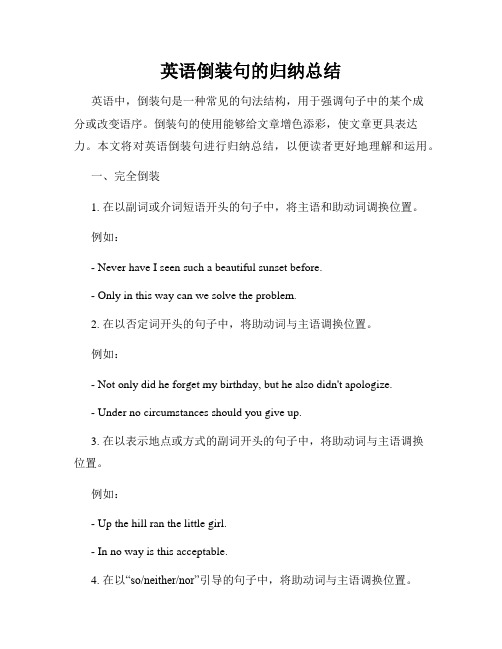
英语倒装句的归纳总结英语中,倒装句是一种常见的句法结构,用于强调句子中的某个成分或改变语序。
倒装句的使用能够给文章增色添彩,使文章更具表达力。
本文将对英语倒装句进行归纳总结,以便读者更好地理解和运用。
一、完全倒装1. 在以副词或介词短语开头的句子中,将主语和助动词调换位置。
例如:- Never have I seen such a beautiful sunset before.- Only in this way can we solve the problem.2. 在以否定词开头的句子中,将助动词与主语调换位置。
例如:- Not only did he forget my birthday, but he also didn't apologize.- Under no circumstances should you give up.3. 在以表示地点或方式的副词开头的句子中,将助动词与主语调换位置。
例如:- Up the hill ran the little girl.- In no way is this acceptable.4. 在以“so/neither/nor”引导的句子中,将助动词与主语调换位置。
例如:- So beautiful is the scenery that it takes my breath away.- Neither have I finished my homework, nor has my brother.二、部分倒装1. 在以“if/whether”引导的条件句中。
例如:- If you work hard, you will achieve your goals.- Whether he comes or not, we will have the party.2. 在以“so that/such that”引导的结果状语从句中。
例如:- He spoke so quickly that I couldn't catch up with him.- The problem is such that it requires a professional to solve it.3. 在以“as/though”引导的方式状语从句中。
倒装句语法知识点归纳总结

倒装句语法知识点归纳总结1. 在以no sooner, hardly, at no time, little, seldom, never, not only等否定词或者否定短语引导的句子中,主语和谓语部分需要倒装。
例如:- No sooner had I arrived at the station than the train left.- Hardly did we start our journey when the rain began to fall.2. 在表示地点或者时间的介词短语放在句首时,需要进行倒装。
例如:- On the corner stood a tall and handsome man.- Under the table lay a sleeping cat.3. 在表示方向的副词放在句首时,需要进行倒装。
例如:- Down the street came a group of excited children.- Up the hill ran the little girl.4. 在以“so+形容词/副词+助动词/情态动词+主语”结构引导的句子中,需要进行倒装。
例如:- So quickly did she finish the test that she had time to review her answers.5. 在以“such+名词+从句”结构引导的句子中,需要进行倒装。
例如:- Such was his love for her that he would do anything for her.总的来说,倒装句的使用可以增强语气,突出句中的某些部分,使句子更具有表现力和影响力。
在写作和口语表达中,适当地运用倒装句可以提高语言的表达能力和水平。
需要注意的是,在使用倒装句时,对于不同的语法规则和用法要有清晰的认识和理解,以避免出现错误的倒装句结构,从而影响句子的意思和表达效果。
英语倒装句的归纳总结

英语倒装句是一种特殊的句子结构,它指的是将谓语动词(或助动词)放在主语前面的句子。
根据倒装的程度,英语倒装句分为完全倒装和部分倒装。
下面我们详细地归纳和总结英语倒装句的类型和用法。
一、完全倒装1. 用于"there be" 句型。
例如:- There is a book on the table.(桌子上有一本书。
)- There will be a party next week.(下周将有一个聚会。
)2. 用于here, there, now, then 等不及物动词主语的句型中,或以in, out, up, down, away 等副词开头的句子里,以表示强调。
例如:- Here comes the bus.(公交车来了。
)- There goes the bell.(铃响了。
)- Now it's your turn.(现在轮到你了。
)3. 当句首状语为表示地点的介词词组时,也常将其全部倒装。
例如:- Outside the door stands a statue.(门外有一尊雕像。
)- From the top of the mountain, we can see the whole city.(从山顶上,我们可以看到整个城市。
)4. 表语置于句首时,倒装结构为"表语连系动词主语"。
例如:- Beautiful it is!(真美啊!)- Rarely has he been late.(他很少迟到。
)二、部分倒装1. 用于so that, so...that... 等句型中,将so 所修饰的形容词或副词置于句首,so 从句用倒装。
例如:- So loudly did he speak that everyone heard him.(他讲话声音如此之大,每个人都听到了。
)2. 用于疑问句中,助动词或情态动词放在主语前面。
例如:- Can you speak English?(你会说英语吗?)- Should we go there now?(我们现在去那里好吗?)3. 用于否定句中,助动词或情态动词放在主语前面。
英语倒装句语法总结
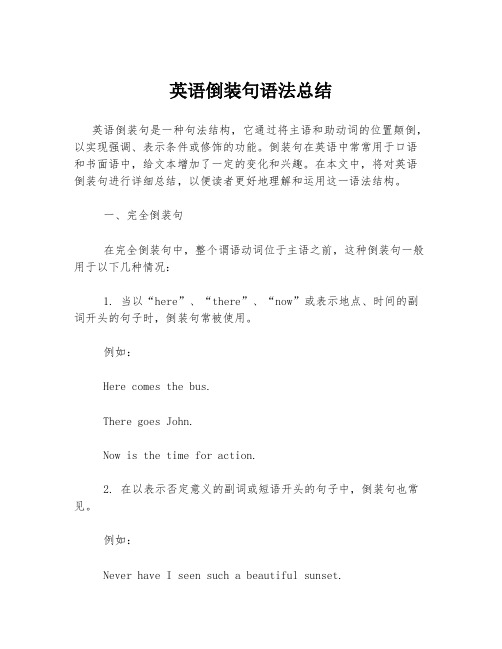
英语倒装句语法总结英语倒装句是一种句法结构,它通过将主语和助动词的位置颠倒,以实现强调、表示条件或修饰的功能。
倒装句在英语中常常用于口语和书面语中,给文本增加了一定的变化和兴趣。
在本文中,将对英语倒装句进行详细总结,以便读者更好地理解和运用这一语法结构。
一、完全倒装句在完全倒装句中,整个谓语动词位于主语之前,这种倒装句一般用于以下几种情况:1. 当以“here”、“there”、“now”或表示地点、时间的副词开头的句子时,倒装句常被使用。
例如:Here comes the bus.There goes John.Now is the time for action.2. 在以表示否定意义的副词或短语开头的句子中,倒装句也常见。
例如:Never have I seen such a beautiful sunset.Not only is she talented, but she is also kind-hearted.3. 在以“only”开头修饰状语从句的句子中,倒装句也经常使用。
例如:Only when you face your fears can you overcome them.Only in this way can the problem be solved.二、部分倒装句部分倒装句中,只将助动词或情态动词放在主语之前,而将主语与谓语动词的位置维持原状。
部分倒装句常用于以下几种情况:1. 当以否定副词“never”、“seldom”或“rarely”开头时,部分倒装句可以被采用。
例如:Never have I been so happy.Seldom does he complain about anything.2. 在以“so”或“such”引导的句子中,为了表达强调,可以使用部分倒装句。
例如:So tired was she that she fell asleep on the couch.Such is the power of love that it can conquer all obstacles.3. 在以“not”开头的句子中,为了增强否定的语气,常常使用部分倒装句。
(完整版)英语倒装句用法经典总结
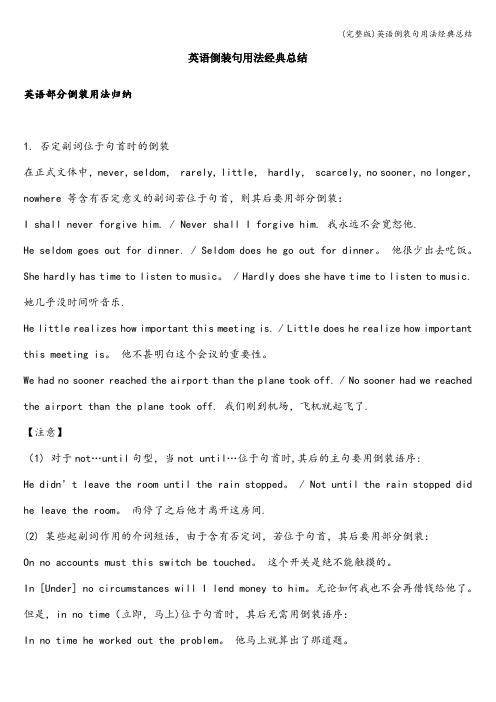
英语倒装句用法经典总结英语部分倒装用法归纳1. 否定副词位于句首时的倒装在正式文体中,never, seldom, rarely, little, hardly, scarcely, no sooner, no longer,nowhere 等含有否定意义的副词若位于句首,则其后要用部分倒装:I shall never forgive him. / Never shall I forgive him. 我永远不会宽恕他.He seldom goes out for dinner. / Seldom does he go out for dinner。
他很少出去吃饭。
She hardly has time to listen to music。
/ Hardly does she have time to listen to music. 她几乎没时间听音乐.He little realizes how important this meeting is. / Little does he realize how important this meeting is。
他不甚明白这个会议的重要性。
We had no sooner reached the airport than the plane took off. / No sooner had we reached the airport than the plane took off. 我们刚到机场,飞机就起飞了.【注意】(1) 对于not…until句型,当not until…位于句首时,其后的主句要用倒装语序:He didn’t leave the room until the rain stopped。
/ Not until the rain stopped did he leave the room。
雨停了之后他才离开这房间.(2) 某些起副词作用的介词短语,由于含有否定词,若位于句首,其后要用部分倒装:On no accounts must this switch be touched。
高中英语倒装句的归纳总结

高中英语倒装句的归纳总结倒装句是英语中的一种特殊语法结构,通常在句子中,主语和谓语动词的位置是固定的,即主语在前,谓语动词在后。
然而,在某些情况下,为了强调句子中的某个成分,或者为了满足特定的语法要求,我们需要将主语和谓语动词的位置颠倒,这就是倒装句。
倒装句在高中英语中经常出现,因此对其进行归纳总结具有重要的意义。
一、全部倒装全部倒装是指句子中的主语和谓语动词完全颠倒的情况,常见于以下几种情况:1. 在以副词here, there或者out, in等表示地点的副词开始的句子中,常常采用全部倒装。
Here comes the bus.(汽车来了。
)There goes the bell.(铃声响了。
)Out rushed the children.(孩子们冲了出去。
)2. 在以表示方向的副词和介词短语开头的句子中,常采用全部倒装。
Down went the sun.(太阳下山了。
)In came the teacher.(老师进来了。
)3. 在以表示否定意义的副词或副词短语开头的句子中,常采用全部倒装。
Never have I seen such a beautiful view.(我从未见过如此美景。
)Not only does he play basketball, but he also plays football.(他不仅打篮球,还踢足球。
)二、部分倒装部分倒装是指只将谓语动词和助动词或情态动词提到主语之前,而将其他成分保持原来顺序的情况。
常见的部分倒装有以下几种情况:1. 在以表示否定意义的副词或副词短语位于句首时,动词与主语之间采用部分倒装。
Never have I been to Paris.(我从未去过巴黎。
)Hardly had she finished her speech when they clapped.(她刚刚讲完演讲就被他们鼓掌了。
)2. 在以so和neither引导的倒装句中,动词与主语之间采用部分倒装。
倒装句的形式总结

倒装句的形式总结倒装句是英语语法中常见的一种句式结构,其基本特点是将谓语动词的助动词或情态动词放在主语之前,或将全部谓语动词放在主语之前。
本文将对倒装句的形式进行总结和说明,帮助读者更好地理解和运用倒装句。
一、完全倒装句形式1.将助动词或情态动词提至主语之前例如:Can you swim?(你会游泳吗?)Should we start now?(我们现在就开始吗?)2.将谓语动词全部提至主语之前例如:Out rushed the students.(学生们冲了出去。
)Never before have I seen such a beautiful sunset.(我从未见过如此美丽的日落。
)3.在以介词短语、副词或副词短语开头的句子中,将介词、副词或副词短语提至主语之前例如:Under the table lay a pile of books.(桌子下放着一堆书。
) On the wall hung a picture.(墙上挂着一幅画。
)Into the room came a cat.(一只猫走进了房间。
)二、部分倒装句形式1.在以否定词开头的句子中,将助动词或情态动词提至主语之前例如:Never have I been so happy.(我从未如此快乐。
)Seldom does he go to parties.(他很少参加聚会。
)Not only did she win the competition, but also set a new record.(她不仅赢得了比赛,还创造了新纪录。
)2.在以表示方向或位置的副词或介词短语开头的句子中,将助动词或情态动词提至主语之前例如:Up flew the birds.(鸟儿飞了起来。
)In rushed the crowd.(人群涌进来。
)Out came the sun.(太阳出来了。
)三、注意事项1.倒装句多用于强调句子中的某一成分,或用于特殊的句子结构,语气较为强烈。
倒装句语法知识点归纳总结
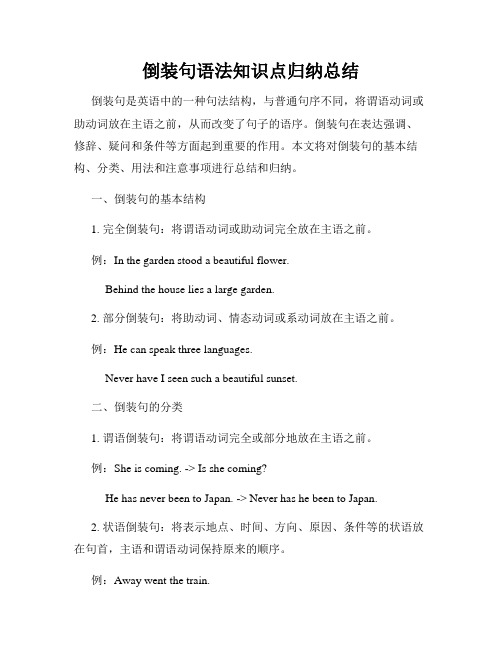
倒装句语法知识点归纳总结倒装句是英语中的一种句法结构,与普通句序不同,将谓语动词或助动词放在主语之前,从而改变了句子的语序。
倒装句在表达强调、修辞、疑问和条件等方面起到重要的作用。
本文将对倒装句的基本结构、分类、用法和注意事项进行总结和归纳。
一、倒装句的基本结构1. 完全倒装句:将谓语动词或助动词完全放在主语之前。
例:In the garden stood a beautiful flower.Behind the house lies a large garden.2. 部分倒装句:将助动词、情态动词或系动词放在主语之前。
例:He can speak three languages.Never have I seen such a beautiful sunset.二、倒装句的分类1. 谓语倒装句:将谓语动词完全或部分地放在主语之前。
例:She is coming. -> Is she coming?He has never been to Japan. -> Never has he been to Japan.2. 状语倒装句:将表示地点、时间、方向、原因、条件等的状语放在句首,主语和谓语动词保持原来的顺序。
例:Away went the train.In the distance could be seen a tall tower.3. 主从倒装句:主句和从句中的主语-谓语结构进行倒装。
例:Not until she finished her homework did she go to bed.Only when the rain stopped could we go outside.三、倒装句的用法1. 强调句:通过倒装句,可以将句子的某一部分进行强调,常用的结构是完全倒装句和部分倒装句。
例:Not only did he win the game, but he also broke the record.Under no circumstances should you touch the red button.2. 疑问句:直接将谓语动词或助动词放在主语之前形成疑问句。
九年级英语常见倒装句最全总结

九年级英语常见倒装句最全总结一、倒装句1.–I usually go hiking with my friends.-- ____do I.A. NorB. SoC. Neither【答案】 B【解析】【分析】句意:一一我经常和朋发一起去徒步旅行。
一一我也是。
肯定句后跟”so+谓语+主语“,表示某人某物也……;否定句后跟"Neither/Nor+谓语+主语”,表示某人某物也不……。
本题前句是肯定句,故选B。
2.一 I didn't watch the football match on TV yesterday.一 . I got home too late to watch it.A. So did IB. Neither did IC. So I didD. Neither I did【答案】 B【解析】【分析】neither/nor+助动词+主语,译为“某人(物)也不……”,如果上句是否定句,那么下句就是也不是这种情况;so+助动词+主语,意为“某人(物)也是……”如果上句是肯定句,那么下句就是也是这种情况。
用于这种结构的主语是不同的人,如果是上下的两句的主语是同一个人,则用半倒装结构,so+主语+助动词,表示“某人的确是这样”。
句意:—我没看昨天的聊天节目,—我也没看,我到家太晚而没有看。
结合句意,故选B。
3.—Oh, my god! Recently I have put on 5 pounds.— . I think I should lose weight.A. So do IB. So have IC. Neither do ID. Neither have I【答案】 B【解析】【分析】句意:—啊,我的天呀!最近我长胖了五磅。
—我也是,我认为我应该减减肥了。
so +主语+助动词/情态动词/系动词:某某确实如此,主语与上文是同一人。
So+助动词/情态动词/系动词+主语:某某也如此,主语与上文不是同一人,表示后者适合前者。
英语倒装句用法经典总结

英语倒装句用法经典总结1.完全倒装句:主语和谓语动词完全倒置。
如:- Never have I seen such a beautiful sunset.(我从未见过如此美丽的日落。
)- Little did he know about the problem.(他对问题一无所知。
)2.部分倒装句:只将助动词或情态动词和主语进行倒置。
如:- Can you swim?(你会游泳吗?)- Should you have any questions, please let me know.(如果你有任何问题,请告诉我。
)3.如果句子以表示地点的副词或介词短语开头,也需要进行倒装。
如:- On the top of the mountain stood a small cabin.(在山顶上有一间小木屋。
)4.如果句子以表示否定意义的副词或介词短语开头,也需要进行倒装。
如:- Under no circumstances will I allow that to happen.(无论如何,我都绝不容许那种事情发生。
5. 在条件句中,如果主语和谓语动词之间使用“had”,“were”或“should”时,需要进行倒装。
如:- Had I known it earlier, I would have prepared better.(要是早知道这个,我会准备得更好。
)- Were I you, I would apologize.(要是我是你,我会道歉。
)以上是英语倒装句的几种常见用法,不同的倒装句用法可以根据具体的语境和语法规则进行灵活运用。
高考英语倒装句最全总结
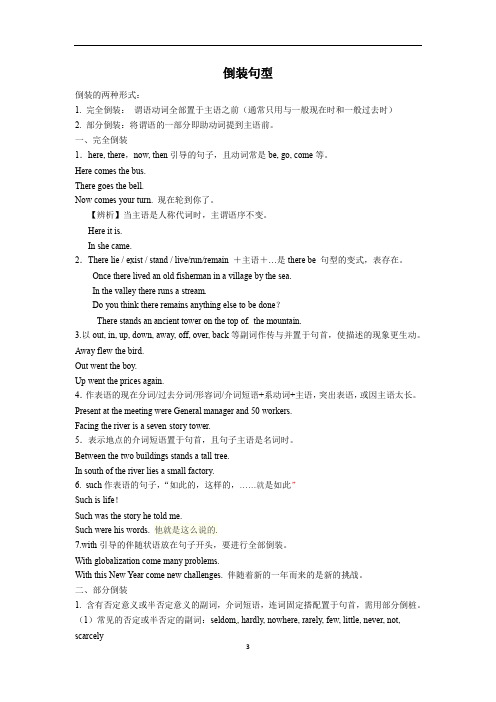
倒装句型倒装的两种形式:1. 完全倒装:谓语动词全部置于主语之前(通常只用与一般现在时和一般过去时)2. 部分倒装:将谓语的一部分即助动词提到主语前。
一、完全倒装1.here, there,now, then引导的句子,且动词常是be, go, come等。
Here comes the bus.There goes the bell.Now comes your turn. 现在轮到你了。
【辨析】当主语是人称代词时,主谓语序不变。
Here it is.In she came.2.There lie / exist / stand / live/run/remain +主语+…是there be 句型的变式,表存在。
Once there lived an old fisherman in a village by the sea.In the valley there runs a stream.Do you think there remains anything else to be done?There stands an ancient tower on the top of the mountain.3.以out, in, up, down, away, off, over, back等副词作传与并置于句首,使描述的现象更生动。
Away flew the bird.Out went the boy.Up went the prices again.4.作表语的现在分词/过去分词/形容词/介词短语+系动词+主语,突出表语,或因主语太长。
Present at the meeting were General manager and 50 workers.Facing the river is a seven-story tower.5.表示地点的介词短语置于句首,且句子主语是名词时。
Between the two buildings stands a tall tree.In south of the river lies a small factory.6.such作表语的句子,“如此的,这样的,……就是如此”Such is life!Such was the story he told me.Such were his words. 他就是这么说的.7.with引导的伴随状语放在句子开头,要进行全部倒装。
倒装句的用法归纳总结

倒装句的用法归纳总结一、完全倒装完全倒装通常只用于一般现在时和一般过去时,常见的结构有:1. 表示时间now,then等或方位here,there,up,down,in,out,away,off,inside,outside等的副词,以及表示地点的介词短语in the room,on the wall 等置于句首,且主语为名词时,句子要用完全倒装结构。
主语为人称代词时不倒装。
There goes the bell.Then came the chairman.At the foot of the mountain lies a village,where people still livea peaceful life.Ahead sat an old woman.Here he comes. Away they went.二、部分倒装1. only所修饰的副词/介词短语/状语从句位于句首时(作状语用)Only in this way, can you learn English well.Only when you are a parent will you understand how I feel now.2. never, hardly, seldom, scarcely, little,not…until, not, no, by no mean, at no time等否定意义的词位于句首时Never have I seen such a performance.Nowhere will you find the answer to this question.Not until the child fell asleep did the mother leave the room.No sooner had they arrived at home than it began to rain heavily.注意:not only…but also连接并列分句时,not only部分要倒装(连接主语时不倒装)Not only did he refuse the gift, he also severely criticized the sender.3. so…that中so或such…that中such位于句首时So frightened was he that he dared not go home alone.Such a careless girl was she that he made the mistake a third time.4. so位于句首表示前句的内容也同样适用于后一个人或物时(只能是肯定句,且前后两句主语不同); neither/nor用于句首,表示前句的否定内容也适用于后一句的人/物时(只能用于否定句,且前后两句主语不同)He likes chatting. So does his wife.If you won't go, neither will I.5. 在虚拟语气中,如果if条件从句有系动词were或助动词should/had,可以把其置于句首,同时省去if.Were it to rain, we would cancel the plan.。
复习专题常见倒装句最全总结

复习专题常见倒装句最全总结复习专题常见倒装句最全总结⼀、倒装句1.–I usually go hiking with my friends.-- ____do I.A. NorB. SoC. Neither【答案】 B【解析】【分析】句意:⼀⼀我经常和朋发⼀起去徒步旅⾏。
⼀⼀我也是。
肯定句后跟”so+谓语+主语“,表⽰某⼈某物也……;否定句后跟"Neither/Nor+谓语+主语”,表⽰某⼈某物也不……。
本题前句是肯定句,故选B。
2.— I can't stand (忍受) the air pollution in this city any more. It is getting more terrible.— ________. We've never had so many factories before.A. Neither I can .B. Neither can IC. So I can.D. So can I.【答案】 B【解析】【分析】句意:-我不能在忍受这个城市⾥的空⽓污染了,它变得更糟糕了。
-我也不能,我们以前从来没有这么多⼯⼚。
Neither也不,是否定意思,位于句⾸,应该⽤倒装,故A不对;C和D应该⽤于肯定句中,这⾥是否定句。
故选B。
3.—I didn't go to Tom's birthday party yesterday. What about you?—________, because I was preparing for the exam all the time.A. Neither was IB. Neither am IC. Neither did ID. Neither do I【答案】 C【解析】【分析】句意:昨天我没有去汤姆的⽣⽇宴会,你呢?——我也没去,因为我⼀直准备考试。
根据倒装句neither助动词-主语,表⽰主语也没去做上⾯的那件事情,根据题意可知是⽤⼀般过去时故助动词⽤did。
倒装句语法总结 -回复

倒装句语法总结倒装句是一种特殊的语法结构,它在英语中经常被使用。
下面是倒装句的几种常见形式和用法的总结:1. 完全倒装:将助动词或情态动词放在主语之前,构成完全倒装句。
情态动词倒装:例如"Can you swim?"(你会游泳吗?)助动词倒装:例如"She has gone."(她已经走了。
)2. 部分倒装:将谓语动词的一部分放在主语之前,构成部分倒装句。
副词或短语倒装:例如"Out came the sun."(太阳出来了。
)否定副词或短语倒装:例如"Never have I seen such a beautiful sight."(我从未见过如此美丽的景象。
)3. 条件句倒装:在以"if"或"should"引导的条件句中,可以发生倒装。
如果主句是肯定句,条件句中要使用"should + 动词原形"的倒装形式:例如"Should you need any help, feel free to ask."(如果你需要帮助,随时问我。
)如果主句是否定句,条件句中要使用"were/should + 主语"的倒装形式:例如"Were I rich, I would travel the world."(要是我有钱,我会周游世界。
)4. 祈使句倒装:在祈使句中,动词原形放在主语之前。
直接祈使句倒装:例如"Open the door."(把门打开。
)否定祈使句倒装:例如"Don't be late."(别迟到。
)需要注意的是,在正常陈述句中并不需要倒装。
倒装句通常用于强调句子的某个部分、提问、表示条件等特殊情况下。
熟练掌握倒装句的用法可以使表达更加灵活生动。
倒装句的四种情况与用法总结

倒装句的四种情况与用法总结倒装句是英语语法中的一种特殊结构,其谓语动词与主语的位置颠倒。
它的运用可以增添句子的丰富性和多样性,使文章表达更加精确和简洁。
本文将介绍倒装句的四种常见情况与用法。
一、完全倒装句完全倒装句的结构是:助动词/情态动词+主语+谓语动词。
这种倒装句常用于以下情况:1.以表示地点或方向的副词开头例如:Up the hill ran the little boy.Down the road came a black cat.2.以表示频率或程度的副词开头例如:Rarely have I seen such a beautiful sunset.So loudly did he speak that everyone turned to look.3.以表示否定意义的副词开头例如:Never have I heard such a bizarre story.Not until then did I realize the severity of the situation.二、部分倒装句部分倒装句是指将助动词/情态动词提前至句首,主语和谓语动词的位置保持不变。
这种倒装句常用于以下情况:1.以表示反义意义的副词开头例如:Hardly had he arrived home when the phone rang.Barely had she finished her speech when the audience applauded.2.以表示条件的状语从句开头例如:Should you need any assistance, please do not hesitate to contact me.Had it not been for your help, I would have failed the exam.三、拓展倒装句拓展倒装句是将某些表语、状语或其他成分提前至句首,与谓语动词形成倒装结构。
高中英语知识点归纳倒装句

高中英语知识点归纳倒装句倒装句是英语语法中的一个重要概念,常常用于强调句子的某个部分或为了实现语法需求。
在高中英语学习过程中,倒装句是必须掌握的一种语法结构。
本文将对倒装句的知识点进行归纳总结,包括倒装语序的基本形式、用途以及一些常见的倒装句类型。
1. 完全倒装在完全倒装中,整个谓语动词位于主语之前,用以强调句子中其他成分。
a. 当句子以副词或短语开头时,通常会使用完全倒装。
例如:- Never have I seen such a beautiful sunset.- In no way could he understand the meaning of the poem.b. 当表示地点或时间的介词短语放在句首时,常常使用完全倒装。
例如:- On the top of the mountain stood a small cottage.- At the end of the corridor hangs a famous painting.c. 当表示“here”、“there”或“out”放在句首时,也会使用完全倒装。
例如:- Here comes the bus!- There goes the bell!2. 部分倒装部分倒装是指将助动词或情态动词与主语之间调换位置,或者将系动词与主语之间调换位置。
它通常用于祈使句、虚拟条件句、以"neither/nor"或"either/or"引导的倒装句等。
a. 在以“May/Can/Will/Should等情态动词”引导的祈使句中,部分倒装会出现。
例如:- May you have a wonderful journey!- Can you please pass me the salt?b. 在虚拟条件句中,当条件句以"had"或"should"开头时,常常使用部分倒装。
倒装句用法归纳

倒装句用法归纳一、完全倒装1.在There be 句型中2.用于“ here (there, now, then)+不及物动词+主语” 的句型中,或以 up, down, out, in, away, off, ahead 等副词开头的句子里,以表示强调。
⑴ Here are some flowers for you.⑵ Then began our new lesson.⑶ Out rushed the boy.⑷ Ahead sat an old man.3.当句首状语为表示地点的介词词组时。
⑴ South of the city lies a big zoo.⑵ From the valley came a frightening sound.⑶ This is our building, on top of which is flying a red flag.4.表语置于句首时,倒装结构为“表语+ 连系动词 + 主语”.⑴ Present at the meeting were Professor White, Professor Smith andmany other guests.⑵ Happy is he who has a sound mind in a sound body.⑶ Gone are the days when they could do what they liked to the Chinesepeople.⑷ Among the goods are Christmas trees, flowers, candles and toys.5.带有直接引语的句子位于引语后面或中间时,通常需全部倒装。
但如果引述动词的主语是代词,或者引述部分后面还有间接宾语,一般不倒装。
⑴ “ I agree with you.” said his parents.⑵ “ Would you like a cup of tea?” he asked politely.⑶“ Our family are going on a trip,” Meimei told me, “ and weare going by bike.”6.用于 so, nor, neither 开头的句子,表示前句所说的内容也适合于另外的人/物。
高考英语倒装句大总结

部分倒装 1. 否定副词位于句首,引起倒装: not only, not until, hardly, scarcely, seldom, rarely, no sooner…than, hardly …when, at no time 决不 1)not until + 时间 + 主谓倒装, not until + 句子+主谓倒装 2)only + recently / then / here /now only + in recently years / in the room only + when you realize …
Hi, Steve, I read an advertisement in today’s China Daily saying the Beijing Ladder Information Company Ltd. is running an English course . They need native speakers of English to teach children and adults . They prefer a university degree . Foreign expert certification is also required . I think you are the proper person they need . If you are interested, please call or write directly to the company .The telephone number is: 0086-10-68019433, and their E-mail address is : Liecbj@. Yours Good luck . Gao Feng
- 1、下载文档前请自行甄别文档内容的完整性,平台不提供额外的编辑、内容补充、找答案等附加服务。
- 2、"仅部分预览"的文档,不可在线预览部分如存在完整性等问题,可反馈申请退款(可完整预览的文档不适用该条件!)。
- 3、如文档侵犯您的权益,请联系客服反馈,我们会尽快为您处理(人工客服工作时间:9:00-18:30)。
常见倒装句最全总结一、倒装句1.——Taking a walk after supper is really a ____ way.——____. It keeps us healthy, too.A. relaxing, So it isB. relaxing, So is itC. relaxed, So it isD. relaxed, So is it【答案】 A【解析】【分析】句意为:---饭后散步确实是放松的办法。
---确实如此。
还可以保持健康。
“so+be动词/助动词/情态动词+主语”属于倒装句肯定形式,表示说话人的行为、动作和前面提到的人的行为、动作相同。
“也”之意;“so+主语+be动词/助动词/情态动词”属于强调句型,表示肯定说话人提到的事是事实,“的确如此”之意。
动词的ed形式表示人的主观感受,动词的ing形式表示事物本身的特性。
结合语境可知应选A。
【点评】考查形容词及固定句型辨析。
2.—I don't understand the story in the new unit. What about you, Bill?—_____.A. Neither I doB. Neither do IC. So do ID. So I do【答案】 B【解析】【分析】句意:——我不懂新单元中的故事。
你呢,比尔?——我也不懂。
表示前面所说的情况同样适用于后面的人或物,用完全倒装结构,前面是否定句用前者用neither/nor+系动词be/助动词/情态动词+主语。
故选B。
【点评】此题考查情景交际。
要注意特殊句式结构的使用。
3.—I didn't go to the cinema yesterday. What about you?—____________, because I was preparing for the project all the time.A. Nor do IB. Neither did IC. Neither am ID. Nor was I【答案】 B【解析】【分析】句意:—我昨天没有去电影院,你的?—我也没去,因为我一直在准备这个项目。
根据句意及题干分析此题是过去也没去,所以选B。
4.—We are not allowed to bring any snacks or drinks at the school meeting.— .A. Neither are weB. Neither do weC. So are weD. So do we【答案】 A【解析】【分析】句意:—我们在学校会议上不被允许带任何零食和饮料。
—我们也是。
根据We are not allowed可知此处表示否定,并且助动词用are,故表示我们也不被允许,用Neither are we。
故选A。
【点评】表示与前面肯定句的情况一样,用句型So+助动词+主语。
表示与前面否定句的情况一样,用句型Neither +助动词+主语。
助动词与前一句的助动词一致。
5.— Peter doesn't know many people here.— __________.A. So do IB. So am IC. Neither am ID. Neither do I【答案】 D【解析】【分析】句意:—皮特不认识这里的很多人。
—我也不认识。
题干是否定句,故用“neithe r+助动词+主语”表示和上句一样也不……;根据doesn't know 可知,用助动词do , 故选D。
【点评】此题考查倒装句。
熟记固定搭配。
6.— I've decided to see the film tonight.— .A. So have IB. So do IC. So did ID. So will I【答案】 A【解析】【分析】句意:——我已经决定了今晚去看这部电影。
——我也已经决定了。
A、我也已经决定了;B、我也现在决定了;C、我也过去决定了;D、我也将会决定。
由上文I've decided to see the film tonight. 我已经决定了今晚看这部电影可知,下文要表达的是‘我也已经决定了’,故选A。
【点评】考查倒装句,so+动词+I句型,表示上述情况也适合于下一个说话的人,动词取决于上文。
7.My sister went to the cinema, and _________________.A. so did IB. so have IC. neither did ID. neither have I【答案】 A【解析】【分析】句意:我姐姐去看电影了,我也是。
went是一般过去时,助动词是did,故排除B和D选项,省略句,so+助动词+主语,用于肯定句,……也是,neither+助动词+主语,用于否定句,……也是,根据My sister went to the cinema,可知是肯定句,故选A。
【点评】考查省略句,注意so+助动词+主语的用法。
8.— Do you know Jim quarreled with his brother?— I don't know, _______________.A. nor do I careB. nor don't I careC. I don't care, neitherD. I don't care, also 【答案】 A【解析】【分析】句意:——你知道吉姆和他哥哥吵架了吗?——我不知道,我也不在乎。
nor+谓语+主语,用于否定句,……也是,故选A。
【点评】考查固定句型,注意nor+谓语+主语的用法。
9.— Would your brother go for a picnic?— If I don't go, __________.A. so does heB. so will heC. neither does heD. neither will he【答案】 D【解析】【分析】句意:你的哥哥去野餐吗?如果我不去,他也不去。
so + 主语+助动词/情态动词/系动词+主语:某某确实如此,与上文是同一人。
so+助动词/情态动词/系动词+主语:某某也如此,与上文不是同一人。
上文是否定句,下文表示某某也不,用neither +助动词+主语。
这些句式在时态,人称上与前一个句子相同。
该句上句是否定句,故选D。
【点评】考查固定句式。
10.-- He swam in the river this summer.-- ________A. So did he.B. So she did.C. So did she.【答案】 C【解析】【分析】“so+助动词(情态动词或连系动词)+另一主语”,此句型是主谓倒装结构,可以表示前面的情况也适用于后者,使用该句型需要注意以几个方面的问题:1.该句型只能用于肯定句,不能用于否定句:如果前句是否定句,则要用“neither /nor +助动词+主语”。
2.句型中的主语与上文中的主语是不同的两个主语3.句型中助动词,包括连系动词和情态动词的时态要和上句中谓语动词的时态相一致。
句意:这个夏天,他在这条河中游泳了。
她也游泳了。
结合语境可知前文情况也适用于后者,故用主谓倒装结构,选C。
【点评】这几个倒装句的区别比较难。
“so+助动词(情态动词或连系动词)+另一主语”,表示前面的情况也适用于后者。
So+主语+助动词(情态动词或连系动词)是对上文所说的情况加以肯定。
如果上文是否定形式则要将so换成neither。
11.— Jim enjoys listening to pop music.— _______________.A. So does Helen.B. Also is HelenC. Helen likes alsoD. So Helen does【答案】 A【解析】【分析】“so+助动词(情态动词或连系动词)+另一主语”,此句型是主谓倒装结构,可以表示前面的情况也适用于后者,使用该句型需要注意以几个方面的问题:1.该句型只能用于肯定句,不能用于否定句:如果前句是否定句,则要用“neither /nor +助动词+主语”。
2.句型中的主语与上文中的主语是不同的两个主语3.句型中助动词,包括连系动词和情态动词的时态要和上句中谓语动词的时态相一致。
根据上文,吉姆喜欢听流行音乐。
可知选A最符合语境,海伦也是。
【点评】考查倒装句。
12.—Will you go to the park tomorrow?—If you don't, ________.A. so do IB. so will IC. neither do ID. neither shall I【答案】D【解析】【分析】句意:—明天你要去公园吗?—如果你不去,我也不去。
so +主语+助动词/情态动词/系动词:某某确实如此,与上文是同一人。
So+助动词/情态动词/系动词+主语:某某也如此,与上文不是同一人。
上文是否定句,下文表示某某也不,用neither +助动词+主语。
这些句式在时态上与前一个句子相同。
倒装句处在条件状语从句中,依据主将从现的原则,倒装句应用将来时态,故选D。
【点评】本题主要考查倒装句式,为了避免和前一句话的内容重复,英语中习惯用so,neither引导的倒装句。
其主语与前一句主语不是同一人。
So表示肯定,neighter表示否定。
其时态与前句的时态保持一致。
另外来考查了主将从现的用法,在条件,让步,时间等状语从句中,主句如果用将来时态,从句用一般现在时态。
13.— I have never visited a paper factory.— .A. So have IB. I haven't nowC. Neither have I【答案】 C【解析】【分析】句意:-我从来没有参观过造纸厂。
-我也没去过。
根据句意可知这里表示的是否定的意思,故A可以先排除,因为so 的这个倒装的用法只能用在肯定句中,表示上面所说的情况也适用于另外一人。
在否定句应该用neither,当neither 位于句首时,应该用倒装的结构。
故选C。
【点评】考查倒装。
14.On the top of the small hill , and it has a long history of more than four hundred years.A. stands an old templeB. an old temple standsC. does an old temple standD. an old temple does stand【答案】 A【解析】【分析】句意:小山顶上矗立着一座古老的寺庙,它有四百多年的悠久历史。
